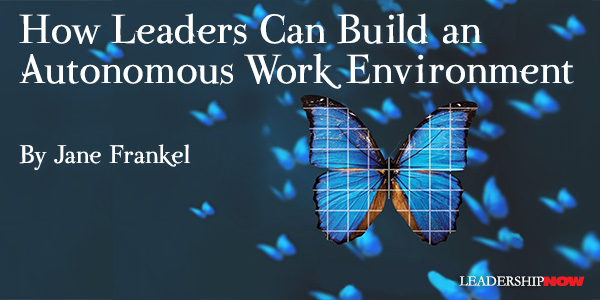 |
 |
11.17.23

How Leaders Can Build an Autonomous Work Environment
IN HIS BOOK Thank You for Being Late, author and award-winning journalist Tom Friedman argues that to understand the twenty-first century, you must realize that “the planet’s three largest forces”—technology, globalization, and climate change—are accelerating all at once. As a business leader, you already get that. But, at the same time, you need to navigate other realities, too—like, for starters, figuring out your own goals and understanding and performing well in your job. Not to mention that the pandemic caused unprecedented distress among workers. Being displaced from their physical work environments, missing their colleagues socially and collaboratively, and losing much of their managers’ usual support, they became increasingly disengaged. They also grew unsure of how to take control of their purpose at work—and in life. Today, however, workers have no choice other than to rise to the occasion: to do their jobs well, to make good and relevant decisions, and to clearly contribute to their organization’s mission and success. And to do all that and more autonomously. But, as reiterated by recent research by Boston Consulting Group, workers first need agency and control—the tenets of autonomy. And, importantly, agency and control require what I call the three selfs: self-confidence, self-accountability, and self-sufficiency. And those selfs must be built and nurtured to take hold. Leaders Must Rise to the Occasion, Too As a leader, your role in creating an autonomous work environment cannot be overstated. You alone have the power to build and nurture workers’ three selfs, and to foster their agency and control. Moreover, to be autonomous in their work, people need to really feel your trust as their leader. And that, in turn, can help them become more and more invested in their own growth and contributions. To get started, here are seven ways to create an autonomous work environment. 1. Reinforce an autonomous narrative. Share your organization’s mindset and narrative around autonomy. Be sure to include current goals for workers’ performance and the ways in which they’re trusted and free to go about doing their jobs. 2. Keep people fully informed. Communicate all relevant information to employees, partners, and other stakeholders on a regular, if not real-time, basis. 3. Have a digital nervous system. Supply workers with a framework of fundamental data and information for analysis in areas such as organizational strategy, industry trends and events, and potential revenue opportunities. 4. Create a project structure. Foster a learning orientation, including an ongoing analysis of prior projects, workflows, and results and outcomes. 5. Recognize and reward value creation. Spotlight key creators and contributors, sharing exactly how they’re adding value to the enterprise. 6. Hold regular reflection sessions. Help people reflect on new business ideas and ways of working, always reinforcing opportunities for intrapreneuring. 7. Balance independence with dependence. Tap into a variety of management theories to emphasize the importance of both working independently and collaborating with others to benefit from their unique expertise and contributions. In closing, as a business leader today, it’s an imperative to create an autonomous work environment. Amid accelerating change, your people need agency and control—imbued by the three selfs—in order to work autonomously, to uncover new opportunities to add value, and to grow and thrive in the 21st-century workplace.  
Posted by Michael McKinney at 12:54 PM
|
BUILD YOUR KNOWLEDGE
 

How to Do Your Start-Up Right STRAIGHT TALK FOR START-UPS 
Grow Your Leadership Skills NEW AND UPCOMING LEADERSHIP BOOKS 
Leadership Minute BITE-SIZE CONCEPTS YOU CAN CHEW ON 
Classic Leadership Books BOOKS TO READ BEFORE YOU LEAD |